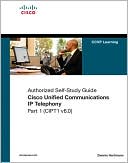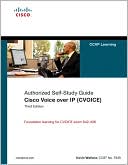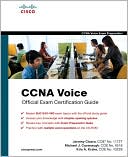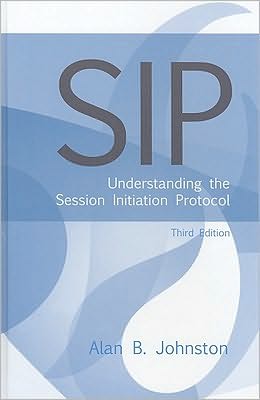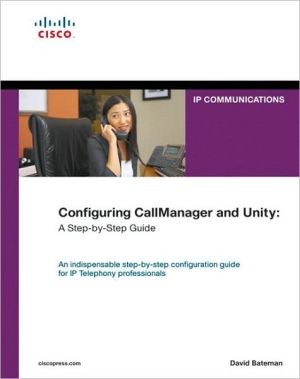Implementing Cisco Unified Communications Manager, Part 1 (CIPT1) (Authorized Self-Study Guide), Vol. 1
Search in google:
Foundation learning for CIPT1 exam 642-446Dennis Hartmann, CCIE® No. 15651Implementing Cisco Unified Communications Manager, Part 1 (CIPT1), is a Cisco®-authorized, self-paced learning tool for CCVP® foundation learning. This book provides the knowledge necessary to install, configure, and deploy a Cisco Unified Communications solution based on Cisco Unified Communications Manager, the call routing and signaling component of the Cisco Unified Communications solution. By reading this book, you will gain an understanding of deploying a Cisco Unified Communications Manager to support single site, centralized, distributed, and hybrid call processing models.This book focuses on Cisco Unified Communications Manager Release 6.x. You will learn how to install and configure Cisco Unified Communications Manager, power over Ethernet switches, and gateways using MGCP. You will also learn how to build a scalable dial plan for on-net and off-net calls. The dial plan chapters of the book cover call routing, call coverage, digit manipulation, class of service, and call coverage components. This book will teach you how to implement media resources, LDAP directory integration, and various endpoints including Skinny Client Control Protocol (SCCP) and Session Initiation Protocol (SIP). Cisco Unified Video Advantag endpoint configuration is covered, in addition to, Cisco Unity® voice mail integration and basic voice mail box creation. Various user features are discussed including Presence.Whether you are preparing for CCVP certification or simply want to gain a better understanding of Cisco Unified Communications Manager fundamentals, you will benefit from thefoundation information presented in this book.Implementing Cisco Unified Communications Manager, Part 1 (CIPT1), is part of a recommended learning path from Cisco that includes simulation and hands-on training from authorized Cisco Learning Partners and self-study products from Cisco Press. To find out more about instructor-led training, e-learning, and hands-on instruction offered by authorized Cisco Learning Partners worldwide, please visit www.cisco.com/go/authorizedtraining.Dennis J. Hartmann, CCIE® No. 15651 is a lead Unified Communications instructor at Global Knowledge. Dennis has been working with CallManager since CallManager 2.0. Dennis has various technical certifications: CCIE No. 15651, CCVP, CCSI, CCNP®, CCIP®, and MCSE. Dennis has worked with various Fortune 500 companies including AT&T, Sprint, Merrill Lynch, KPMG, and Cabletron Systems. Understand Cisco Unified Communications Manager architecture and components Evaluate Cisco Unified Communications Manager deployment models Install, upgrade, and administer Cisco Unified Communications Manager Apply network configuration, NTP, and DHCP configuration options Configure and manage user accounts Deploy various Cisco Unified IP Phones Configure Catalyst® switches for power over Ethernet and voice VLAN requirements Harden IP Phones to mitigate security risks Configure Media Gateway Control Protocol (MGCP) gateways Configure dial plans, call routing, and digit manipulation Deploy various media resources and user features Integrate Cisco Unity Voicemail with Cisco Unified Communications Manager Configure video-enabled IP PhonesThis volume is in the Certification Self-Study Series offered by Cisco Press®. Books in this series provide officially developed self-study solutions to help networking professionals understand technology implementations and prepare for the Cisco Career Certifications examinations.Category: Cisco Unified Communications Manager 6Covers: CIPT1 exam 642-446$65.00 USA / $72.00 CAN
Foreword xixIntroduction xxChapter 1—Cisco Unified Communications Manager Architecture 3Chapter Objectives 3CUCM Overview 4 Cisco UC Solution Components 4 Cisco UC Network 7 CUCM Functions 8 CUCM Signaling and Media Paths 10 Example: Basic IP Telephony Call 10 CUCM Hardware, Software, and Clustering 11 CUCM Cluster 13 Cisco 7800 Series Media Convergence Servers 14 Cisco UC Operating System 14 Cisco UC Database 15 Static Configuration Data 15 User-Facing Features 15 Database Access Control 17 CUCM Licensing 18 License File Request Process 21 Obtaining Additional Licenses 22 Licensing Components 22 Calculating License Units 25 License Unit Reporting 25Chapter Summary 27Review Questions 28Chapter 2—Deployment Models 33Chapter Objectives 33CUCM: Single-Site Deployment 34Multisite WAN with Centralized Call Processing 36Multisite Deployment with Distributed Call Processing 39 Benefits 42 Best Practices 42Clustering over the IP WAN 43CUCM Call-Processing Redundancy 45Chapter Summary 48Review Questions 49Chapter 3—Installation and Upgrade 53Chapter Objectives 53CUCM Installation and Upgrade Overview 53 CUCM Installation and Upgrade Options 54 Basic Install 54 Upgrade During Install 55 Windows Upgrade 55 5.x or Later Upgrade 55 Upgrade Methods 55 Installation Disc 56 Hardware Configuration 56 Basic Installation (Installation DVD) 56 Important Configuration Information 57 Installation Procedures for Basic Install 61 Basic Installation (Preinstalled) 62 Upgrade During Install 63 Windows Upgrade 66 CUCM 5.x and 6.x Upgrades 67 Dual Partitions 68Chapter Summary 68Review Questions 69Chapter 4—Administration 71Chapter Objectives 71CUCM User Interface Options 72 CUCM User Options Interface 73 CUCM Administration Interface 75 Cisco Unified Serviceability Interface 76 Disaster Recovery System 78 Operating System Administration 79 Command-Line Interface 81Chapter Summary 82Review Questions 83Chapter 5—Initial Configuration Settings 87Chapter Objectives 87CUCM Initial Configuration 88 Network Components 88 Network Time Protocol 88 Dynamic Host Configuration Protocol 89 Trivial File Transfer Protocol 89 Domain Name System 89 NTP and DHCP Considerations 90 DHCP 92 DNS 94Network and Feature Services 97 Network Services 98 Feature Services 98 Service Activation 99 Control Center 99 Global Server Settings 100 Enterprise Parameters 100 Service Parameters 104Chapter Summary 107Review Questions 108Chapter 6—Managing User Accounts 113Chapter Objectives 113CUCM User Accounts 113 User Account Types 114 User Privileges 115 User Management 118 Managing User Accounts 119Lightweight Directory Access Protocol 125 LDAPv3 Integration 126LDAPv3 Synchronization 127 Synchronization Agreements 128 Synchronization Search Base 129 Synchronization Best Practices 131LDAPv3 Synchronization Configuration 132 LDAPv3 Authentication 134 LDAPv3 Authentication Configuration 137Chapter Summary 138Review Questions 138Chapter 7—Endpoints 143Chapter Objectives 143CUCM Endpoints 144 Endpoint Features 145 Cisco IP Phone Models 147 Entry-Level Cisco IP Phones 147 Midrange Cisco IP Phones 148 High-End Cisco IP Phones 148 Other Cisco IP Phones 149Cisco IP Phones: Boot Sequence 151H.323 Endpoint Support 155SIP Third-Party IP Phone Support in CUCM 157 SIP Third-Party Authentication 159Chapter Summary 161Review Questions 161Chapter 8—Cisco Catalyst Switches 165Chapter Objectives 165Cisco LAN Switches 166 Providing Power to Cisco IP Phones 167 Cisco Prestandard Power over Ethernet Device Detection 169 IEEE 802.3af Device Detection 169 Voice VLAN Support on Cisco IP Phones 171 Single VLAN Access Port 173 Multi-VLAN Access Port 174 802.1q Trunk Port 175 Native Cisco IOS VLAN Configuration 176 CatOS VLAN Configuration 178Chapter Summary 180Review Questions 180Chapter 9—CUCM Configuration 185Chapter Objectives 185Endpoint Configuration Tools and Elements Overview 186Endpoint Basic Configuration Elements 187 Device Pool 187 Phone Network Time Protocol Reference 189 Date/Time Groups 190 Cisco Unified CM Group 191 Regions 192 Locations 193 Phone Security Profile 194Device Settings 195 Device Defaults 196 Phone Button Template 197 Softkey Template 198 SIP Profile 199 Common Phone Profiles 200Phone Configuration Element Relationship 201IP Phone Auto Registration 202 Auto-Registration Configuration 204Bulk Administration Tool and Tool for Auto'Registered Phone Support 206 Tool for Auto-Registered Phone Support 207 TAPS: Phone Insert Process 207 Bulk Administration Tool 208 Bulk Provisioning Service 209 Phone Template 209 Line Template 210 CSV File Upload 211 Phone Validation 212 Inserting IP Phones into the CUCM Database 213Manual Configuration 214 Endpoint Registration Verification 217 Third-Party SIP Phone Configuration 218Hardening Cisco IP Phones 221 PC Port 222 Settings Access 222 Cisco IP Phones Web Services 222 Gratuitous Address Resolution Protocol 223 PC Voice VLAN Access 225Chapter Summary 227References 227Review Questions 228Chapter 10—Configuring Voice Gateways 231Chapter Objectives 231Media Gateway Control Protocol Gateways 231 Endpoint Identifiers 232 MGCP Gateway Support 234MGCP Configuration Server 236 Q.931 Backhaul 237 MGCP Gateway Configuration: CUCM 237 MGCP Gateway Configuration: Cisco IOS Configuration 242 MGCP Gateway: Registration Verification 245Chapter Summary 246References 247Review Questions 247Chapter 11—Call Routing Components 251Chapter Objectives 251Endpoint Addressing 251Uniform On-Net Dial Plan Example 253Call Routing 255 Call Routing Table Entries 257 Route Patterns 257 Route-Pattern Examples 259 Digit Analysis 260Digit Forwarding 264 SCCP Phones: User Input 265 SIP Phones: User Input 266 Type A SIP Phones: No Dial Rules 266 Type A SIP Phones: Dial Rules 267 Type B SIP Phones: No Dial Rules 268 Type B SIP Phones: Dial Rules 269CUCM Path Selection 269 Path-Selection Elements 270 Path-Selection Configuration 270 Route Group 271 Route List 272Route Filters 276Call Classification 278Chapter Summary 279References 279Review Questions 280Chapter 12—Digit Manipulation 283Chapter Objectives 283CUCM Digit Manipulation 284 CUCM Digit Manipulation Overview 284External Phone Number Mask 287CUCM Digit Prefix and Stripping 288CUCM Transformation Masks 291Translation Patterns 293Significant Digits 297Transformation Examples 298Chapter Summary 300Review Questions 301Chapter 13—Calling Privileges 305Chapter Objectives 305Calling Privileges 306Partitions and Calling Search Spaces 307Time-of-Day Call Routing 319Client Matter Codes and Forced Authorization Codes 323Class of Service Approaches 327911 and Vanity Numbers 331 Private Line Automatic Ringdown 333Chapter Summary 334Review Questions 335Chapter 14—Call Coverage 339Chapter Objectives 339Call Coverage 340Call Hunting 342 Call-Hunting Options and Distribution Algorithms 346 Call-Hunting Flow 348 Call-Hunting Configuration 350Chapter Summary 361Review Questions 362Chapter 15—Media Resources 367Chapter Objectives 367Media Resources 367Media Resource Support 369Conferencing 374 Cisco Conference Bridge Hardware 376 Cisco Conference Bridge Hardware (Cisco Catalyst WS-X6608-T1 and WS-X6608-E1) 376 Cisco IOS Conference Bridge (Cisco NM-HDV and 1700 Series Routers) 376 Cisco Conference Bridge (Cisco WS-SVC-CMM-ACT) 377 Cisco IOS Enhanced Conference Bridge (Cisco NM-HDV2, NM-HD-1V/2V/2VE, 2800 Series, and 3800 Series Routers) 377 Conferencing Media Resource Configuration 379 Meet-Me Conference Configuration 387Music on Hold 388 MoH Configuration 391Annunciator 396Media Resource Access Control 398Chapter Summary 402Review Questions 403Chapter 16—User Features 407Chapter Objectives 407Call Park 407Call Pickup 411 Call-Pickup Example 411 Group Pickup Example 411Hold Reversion 414Do Not Disturb 416Intercom 418Call Back 422 Example: Cisco Call Back 422Barge and Privacy 423User Web Pages 427IP Phone Services 429 Guidelines and Tips 429Chapter Summary 430Review Questions 431Chapter 17—Presence-Enabled Speed Dials and Lists 435Chapter Objectives 435Presence 436Presence Support in CUCM 436Presence Configuration 439Presence Policies 442 Presence Policy Configuration 446Chapter Summary 450References 450Review Questions 451Chapter 18—Voice-Mail System Integration 455Chapter Objectives 455Cisco Unity Overview 455Voice-Mail Integration 459 Call Routing to Cisco Unity 461 Outside Calls 461 Subscriber Call Flow 463 Calls Forwarded to Voice Mail 465 Accessing Messages 466Configuration for Cisco Unity Integration 467Integrating CUCM with a Cisco Unity Voice-Mail System 471 Creating MWI 472 Adding Voice-Mail Ports 472 Adding a Line Group 473 Adding a Hunt List 475 Adding a Hunt Pilot 476 Configuring a Voice-Mail Pilot 477 Configuring a Voice-Mail Profile 477Phone Configuration for Voice-Mail Usage 478Cisco Unity Configuration 479Cisco Unity Subscriber Configuration 484Chapter Summary 485References 486Review Questions 486Chapter 19—Cisco Unified Video Advantage 489Chapter Objectives 489CUVA Overview 489CUVA Communication Flows 491CUCM Configuration 494CUVA Installation 498CUVA Verification Tools 500Chapter Summary 502References 503Review Questions 503Appendix A—Answers to Review Questions 507TOC, 1587054833, 5/6/2008
